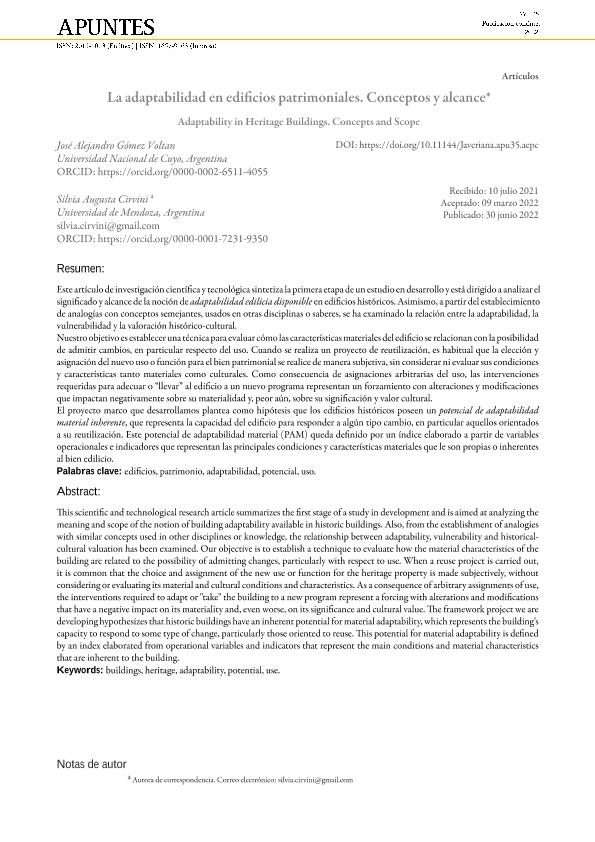Mostrar el registro sencillo del ítem
dc.contributor.author
Cirvini, Silvia Augusta

dc.contributor.author
Gomez Voltan, Jose Alejandro

dc.date.available
2023-10-27T13:30:22Z
dc.date.issued
2022-09
dc.identifier.citation
Cirvini, Silvia Augusta; Gomez Voltan, Jose Alejandro; La adaptabilidad en edificios patrimoniales: Conceptos y alcance; Pontificia Universidad Javeriana; Apuntes; 35; 9-2022; 1-21
dc.identifier.issn
1657-9763
dc.identifier.uri
http://hdl.handle.net/11336/216152
dc.description.abstract
Este artículo de investigación científica y tecnológica, sintetiza la primera etapa de un estudio en desarrollo y está dirigido a analizar el significado y alcance de la noción de “adaptabilidad edilicia disponible” en edificios históricos. Asimismo, a partir de establecer analogías con conceptos semejantes usados en otras disciplinas o saberes se ha examinado la relación entre la adaptabilidad, la vulnerabilidad y la valoración histórico-cultural. Nuestro objetivo es establecer una técnica para evaluar cómo las características materiales del edificio se relacionan con la posibilidad de admitir cambios, en particular respecto del uso. Cuando se realiza un proyecto de reutilización, es habitual que la elección y asignación del nuevo uso o función para el bien patrimonial se realice de manera subjetiva, sin considerar ni evaluar sus condiciones y características tanto materiales como culturales. Como consecuencia de asignaciones arbitrarias del uso, las intervenciones requeridas para adecuar o “llevar” al edificio a un nuevo destino representan un forzamiento con alteraciones y modificaciones que impactan negativamente sobre su materialidad y peor aún, sobre su significación y valor cultural. El proyecto marco que desarrollamos plantea como hipótesis que los edificios históricos poseen un potencial de adaptabilidad material inherente que representa la capacidad del edificio para responder a algún tipo cambio, en particular aquel orientado a su reutilización. Este potencial de adaptabilidad material (PAM) queda definido por un índice elaborado a partir de variables operacionales e indicadores que representan las principales condiciones y características materiales que le son propias o inherentes al bien edilicio.
dc.description.abstract
This scientific and technological research article summarizes the first stage of a study in development and is aimed at analyzing the meaning and scope of the notion of building adaptability available in historic buildings. Also, from the establishment of analogies with similar concepts used in other disciplines or knowledge, the relationship between adaptability, vulnerability and historicalcultural valuation has been examined. Our objective is to establish a technique to evaluate how the material characteristics of the building are related to the possibility of admitting changes, particularly with respect to use. When a reuse project is carried out, it is common that the choice and assignment of the new use or function for the heritage property is made subjectively, without considering or evaluating its material and cultural conditions and characteristics. As a consequence of arbitrary assignments of use, the interventions required to adapt or "take" the building to a new program represent a forcing with alterations and modifications that have a negative impact on its materiality and, even worse, on its significance and cultural value. The framework project we are developing hypothesizes that historic buildings have an inherent potential for material adaptability, which represents the building's capacity to respond to some type of change, particularly those oriented to reuse. This potential for material adaptability is defined by an index elaborated from operational variables and indicators that represent the main conditions and material characteristics that are inherent to the building.
dc.format
application/pdf
dc.language.iso
spa
dc.publisher
Pontificia Universidad Javeriana
dc.rights
info:eu-repo/semantics/openAccess
dc.rights.uri
https://creativecommons.org/licenses/by/2.5/ar/
dc.subject
EDIFICIOS
dc.subject
PATRIMONIO
dc.subject
ADAPTABILIDAD
dc.subject
USO
dc.subject.classification
Ingeniería Arquitectónica

dc.subject.classification
Ingeniería Civil

dc.subject.classification
INGENIERÍAS Y TECNOLOGÍAS

dc.title
La adaptabilidad en edificios patrimoniales: Conceptos y alcance
dc.title
Adaptability in Heritage Buildings: Concepts and Scope
dc.type
info:eu-repo/semantics/article
dc.type
info:ar-repo/semantics/artículo
dc.type
info:eu-repo/semantics/publishedVersion
dc.date.updated
2023-10-26T15:09:31Z
dc.identifier.eissn
2011-9003
dc.journal.volume
35
dc.journal.pagination
1-21
dc.journal.pais
Colombia

dc.journal.ciudad
Bogotá
dc.description.fil
Fil: Cirvini, Silvia Augusta. Consejo Nacional de Investigaciones Científicas y Técnicas. Centro Científico Tecnológico Conicet - Mendoza. Instituto de Ciencias Humanas, Sociales y Ambientales; Argentina
dc.description.fil
Fil: Gomez Voltan, Jose Alejandro. Consejo Nacional de Investigaciones Científicas y Técnicas. Centro Científico Tecnológico Conicet - Mendoza. Instituto de Ciencias Humanas, Sociales y Ambientales; Argentina
dc.journal.title
Apuntes
dc.relation.alternativeid
info:eu-repo/semantics/altIdentifier/url/https://dialnet.unirioja.es/servlet/articulo?codigo=8554098
dc.relation.alternativeid
info:eu-repo/semantics/altIdentifier/url/https://revistas.javeriana.edu.co/index.php/revApuntesArq/article/view/34138
dc.relation.alternativeid
info:eu-repo/semantics/altIdentifier/doi/https://doi.org/10.11144/Javeriana.apu35.aepc
Archivos asociados
